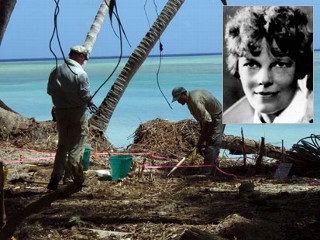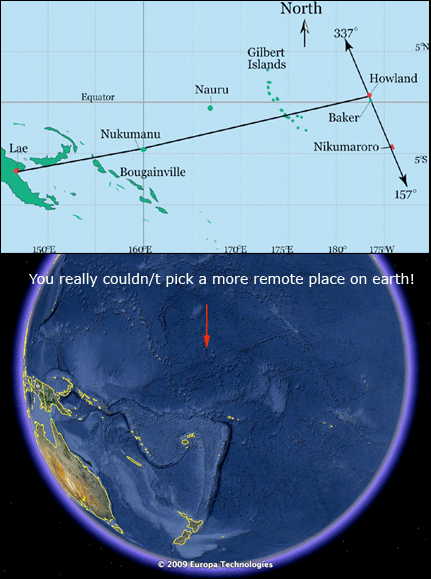The Search
It has been 72 years since famed aviator Amelia Earhart and navigator Fred Noonan disappeared while attempting to fly around the world. But the mystery remained unsolved: Nobody knew exactly what happened to Earhart or her plane.
 The 1937 disappearance of aviation pioneers is a mystery that continues to fascinate. Several drastically different hypothetical answers have been provided to the question: "What happened to Amelia Earhart?"
The 1937 disappearance of aviation pioneers is a mystery that continues to fascinate. Several drastically different hypothetical answers have been provided to the question: "What happened to Amelia Earhart?" Possible theories include:
- Ran out of gas and crashed into the Pacific
- Captured by the Japanese and executed
- Captured by the Japanese and survived
- Hidden as part of an elaborate espionage operation by the U.S., Great Britain, or others
- Trapped in a time/space warp
- Became Tokyo Rose
- Returned to the U.S. and died in the 1990s
- The Nikumaroro Hypothesis - landed, survived for awhile, and died on Nikumaroro atoll in the Phoenix Islands.
Researchers at the International Group for Historic Aircraft Recovery, or Tighar, say they are on the verge of evaluating DNA evidence that would demonstrate Earhart had been stranded on Nikumaroro Island (formerly known as Gardner Island) before finally perishing there.
"Propagation analysis of nearly 200 radio signals heard for several days after the disappearance make it virtually indisputable that the airplane was on land," Tighar's Executive Director, Ric Gillespie, said.
Eventually, Earhart's twin-engine plane, the Electra, was ripped apart by Nikumaroro's strong waves and swept out into deep water, leaving no visible trace.
"The evidence is plentiful -- but not conclusive yet -- to support the hypothesis that Amelia landed and died on the island of Nikumaroro," forensic anthropologist Karen Ramey Burns told Discovery News.
The author of a book on Earhart, Burns believes that the strongest of the amassed evidence comes from the report related to the partial skeleton found by a researcher named Gallagher.
"The skeleton was found to be consistent in appearance with females of European descent in the United States today, and the stature was consistent with that of Amelia Earhart," said Burns.
 During a 2007 expedition to Nikumaroro, Gillespie and his crew uncovered early 20th-century makeup and two pieces of broken glass that match a 1930s compact mirror, among other artifacts. DNA can be extracted from such remnants as long as those artifacts aren't contaminated during the collection process. Unfortunately, in 2007, they were. Armed with a new collection protocol, Gillespie and his team hope newly discovered skeletal remains will provide the DNA samples for comparison.
During a 2007 expedition to Nikumaroro, Gillespie and his crew uncovered early 20th-century makeup and two pieces of broken glass that match a 1930s compact mirror, among other artifacts. DNA can be extracted from such remnants as long as those artifacts aren't contaminated during the collection process. Unfortunately, in 2007, they were. Armed with a new collection protocol, Gillespie and his team hope newly discovered skeletal remains will provide the DNA samples for comparison. A woman directly related to Earhart, who wishes to remain anonymous, agreed to provide Gillespie's group with a reference sample of mitochondrial DNA. This type of genetic material differs from nuclear DNA in many ways, primarily because it's passed down the female line. Mitochondrial DNA, also referred to as mtDNA, is often used in forensics research. Because mtDNA is found in the cell's mitochondria, rather than the chromosomes of the cell's fragile nucleus, it isn't as quick to break down even when subject to difficult environmental conditions.
According to Burns, another piece of documentary evidence comes from the accounts of Lt. John O. Lambrecht, a U.S. Naval aviator participating in the search for Earhart's plane. Lambrecht reported "signs of recent habitation" on what was officially (then) an uninhabited atoll.
Lambrechet's report begs the question: Why did no one follow up?
"I have stood in plain sight on Nikumaroro in a white shirt waving wildly as a helicopter flew over me and was not noticed until the video tape of the flight was examined," Burns said.
"I find it very easy to believe that Amelia and Fred would not have been seen by the pilot. If the Electra was not visible at the time, their last chance of rescue was lost in Lambrecht's notes," she added.
Abandoned on a desert island where temperatures often exceed 100 degrees, even in the shade, Earhart and Noonan likely eventually succumbed to any number of causes, including injury and infection, food poisoning from toxic fish, or simply dehydration.
The coconut crabs' great pincers would have done the rest, likely removing some of the last physical traces of this pioneering aviatrix.
Coconut Crab

Map shows location of the Nikumaroro atol. Australia is just visible on the left. The Hawaiian Islands are not visible because of the graphic overlay but are located in the upper right of the globe. This has to be one of the most remote places on planet Earth.


No comments:
Post a Comment